Reward Pathways & Dopamine
1/83
There's no tags or description
Looks like no tags are added yet.
Name | Mastery | Learn | Test | Matching | Spaced |
|---|
No study sessions yet.
84 Terms
What is psychological dependence?
Psychological dependence refers to craving, compulsive drug use, loss of control, and addiction.
What is physical dependence?
: Physical dependence occurs when stopping a drug causes withdrawal symptoms.
What is tolerance?
Tolerance happens when continued use of a drug results in the need for increasing doses to achieve the same effect.
What is the biological basis for reward in the brain?
It’s a network of brain regions known as the reward pathway that reinforces pleasurable or survival-related behaviors through dopamine release.
What is the main reward pathway in the brain called?
: The mesolimbic pathway.
Where does the mesolimbic pathway begin and end?
It begins in the ventral tegmental area (VTA) and projects to the nucleus accumbens in the ventral striatum.
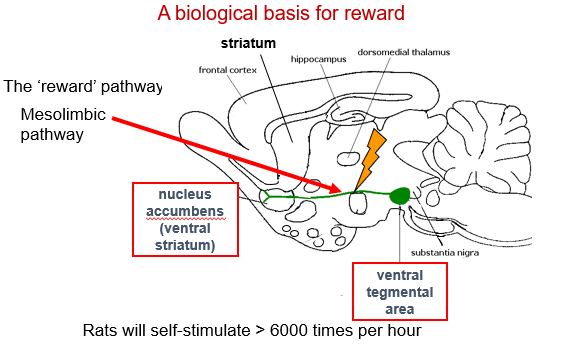
What neurotransmitter is primarily involved in the reward pathway?
Dopamine.
What is the function of the nucleus accumbens?
It is a key part of the ventral striatum that processes reward, pleasure, and motivation.
What role does the ventral tegmental area (VTA) play in reward?
it produces dopamine and sends it to other reward-related areas, including the nucleus accumbens.
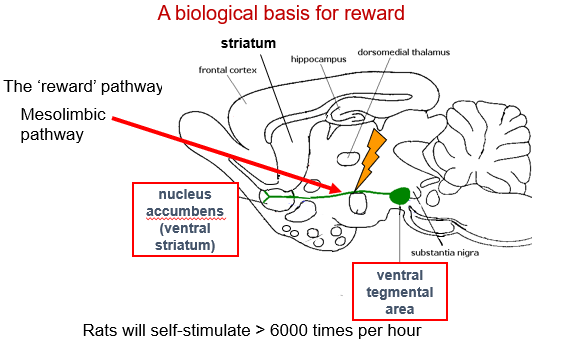
How is the substantia nigra related to the reward pathway?
It’s another dopamine-producing region, primarily involved in movement, but closely connected to the reward system.
What role does dopamine play in intracranial self-stimulation (ICSS)?
During ICSS, dopamine is released in the nucleus accumbens, reinforcing the behavior and making the stimulation rewarding for the animal.
What effect do dopamine D1 or D2 antagonists have when administered directly into the nucleus accumbens?
They block dopamine receptors, reducing the rewarding effects of ICSS and decreasing the animal’s motivation to self-stimulate.
What do studies using microdialysis, ICSS, and dopamine antagonists reveal about the brain’s reward system?
they show that dopamine activity in the mesolimbic pathway—especially between the VTA and nucleus accumbens—is essential for experiencing and seeking rewards.
What is the role of the ventral tegmental area (VTA) in the brain’s reward system?
The VTA contains dopaminergic neurons that release dopamine and project to the nucleus accumbens, forming part of the mesolimbic reward pathway.
How are the VTA and nucleus accumbens connected?
They are linked by the mesolimbic dopamine pathway, where dopamine from the VTA is released into the nucleus accumbens to produce feelings of reward and motivation.
What is 6-hydroxydopamine (6-OHDA)?
6-OHDA is a neurotoxin that selectively destroys dopaminergic neurons in the brain.
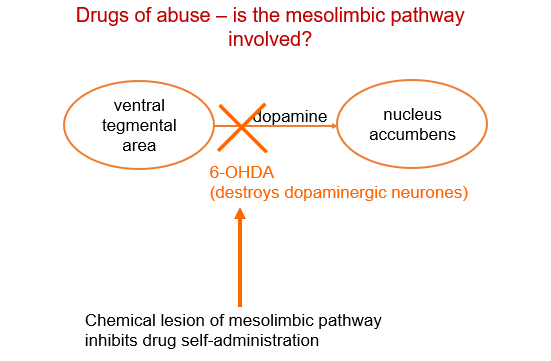
What happens when 6-OHDA is used to lesion the mesolimbic pathway?
: It destroys dopamine-producing neurons between the VTA and nucleus accumbens, reducing dopamine transmission
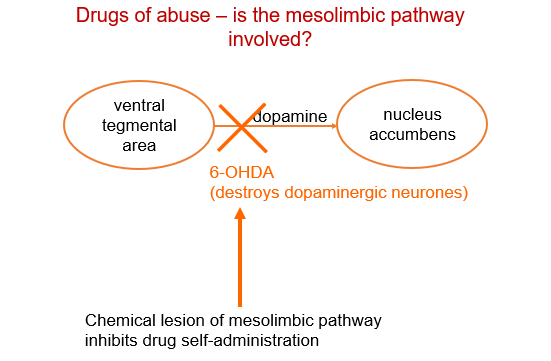
How does a chemical lesion (6-ohda) of the mesolimbic pathway affect drug self-administration?
It inhibits drug self-administration because the rewarding dopamine signal is lost, showing that dopamine release is essential for drug reinforcement.
What neurotransmitter acts on D1 and D2 receptors in the nucleus accumbens?
Dopamine, released from the ventral tegmental area (VTA), acts on D1 and D2 receptors to produce feelings of reward and reinforcement
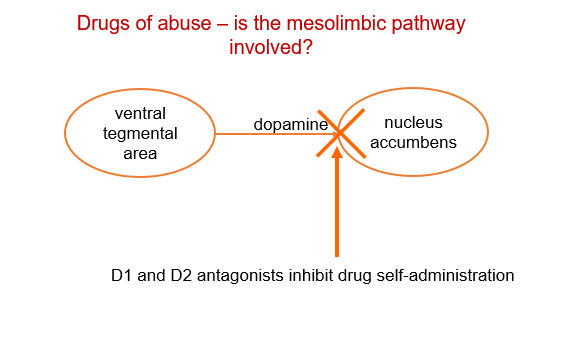
What happens when D1 or D2 antagonists are administered into the nucleus accumbens?
: They block dopamine receptor activity and inhibit drug self-administration, reducing the rewarding effects of drugs.
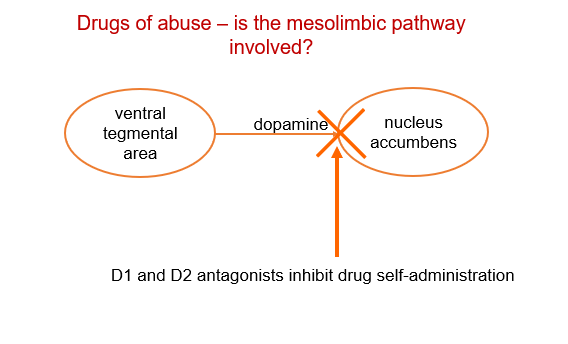
What does the effect of D1 and D2 antagonists show about dopamine’s role in reward?
It shows that dopamine receptor activation is essential for reward and reinforcement; without it, the motivation to seek drugs decreases.
What are D1 and D2 agonists, and how do they affect behavior?
: D1 and D2 agonists activate dopamine receptors, and animals will self-administer them, showing that receptor activation alone is rewarding.
What happens when both D1 and D2 agonists are given together?
The animal needs a lower dose to find it rewarding, indicating synergy between the D1 and D2 receptor systems.
Why is the function of D1 and D2 receptors in the nucleus accumbens considered complex?
Because they act on different types of neurons, have opposite effects (stimulatory vs. inhibitory), and interact in complex feedback loops that are not yet fully understood
How do these findings fit into the overall mesolimbic dopamine pathway model?
Dopamine released from the VTA activates D1 and D2 receptors in the nucleus accumbens; blocking these receptors stops reward behaviors, while activating them enhances them, confirming dopamine’s key role in the brain’s reward system.
What happens to dopamine levels in the mesolimbic system when addictive drugs are taken?
Synaptic dopamine concentrations increase, meaning more dopamine is available to activate reward receptors.
How do drugs like cocaine and amphetamine increase dopamine in the synapse?
Cocaine blocks dopamine reuptake by inhibiting the dopamine transporter (DAT).
Amphetamine causes neurons to release extra dopamine into the synapse.
How does cocaine increase dopamine levels in the nucleus accumbens?
Cocaine blocks dopamine reuptake by inhibiting the dopamine transporter (DAT), allowing dopamine to remain longer in the synapse.
How does amphetamine increase dopamine levels in the nucleus accumbens?
mphetamine causes neurons to release more dopamine directly into the synapse, increasing dopamine concentration.
Despite different pharmacologies, what common effect do cocaine and amphetamine have in the brain?
Both increase dopamine levels in the nucleus accumbens, enhancing reward signaling.
What role do GABAergic neurons play in dopamine signaling in the nucleus accumbens?
: GABAergic neurons normally inhibit dopamine release, helping regulate dopamine signaling.
How do drugs like cocaine and amphetamine affect GABAergic regulation?
They disrupt the balance by increasing dopamine levels, which overrides the inhibitory control of GABAergic neurons.
How do opioids like morphine, heroin, methadone, and oxycodone differ pharmacologically from drugs like cocaine or amphetamine?
They primarily act on mu-opioid receptors (MOR) located on GABAergic neurons in the ventral tegmental area (VTA), unlike cocaine or amphetamine which directly affect dopamine neurons.
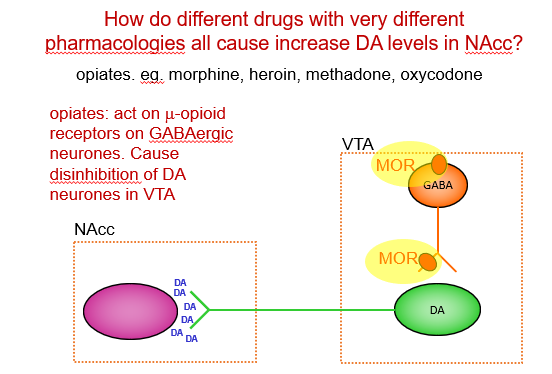
What role do GABAergic neurons in the VTA normally play in dopamine release?
GABAergic neurons normally inhibit dopamine neurons, keeping dopamine release under control.
What happens when opioids bind to mu-opioid receptors on GABAergic neurons?
They inhibit the GABAergic neurons, causing disinhibition of dopamine neurons.
What is meant by "disinhibition" in the context of opioid action?
It means inhibiting the inhibitory GABA neurons, which lifts the brake on dopamine neurons, allowing them to fire more.
What is the consequence of disinhibition of dopamine neurons in the VTA?
Dopamine neurons increase firing and release more dopamine into the nucleus accumbens (NAcc).
How does increased dopamine in the nucleus accumbens affect behavior?
It produces rewarding and reinforcing effects, contributing to addiction.
Summarize the effect of opioids on the mesolimbic dopamine pathway.
Opioids act on MORs on GABA neurons in the VTA, causing disinhibition of dopamine neurons, which release more dopamine in the NAcc, leading to reward and reinforcement.
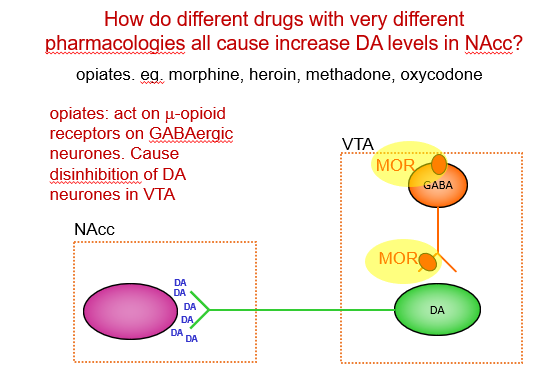
What type of receptor do opiates like morphine and heroin bind to?
opiates bind to opioid receptors, which are G-protein coupled receptors (GPCRs) coupled specifically to the Gi/o protein family.

What happens when an opioid receptor is activated by an opiate?
t engages the Gi/o protein, which inhibits adenylyl cyclase (AC).
What is the normal function of adenylyl cyclase (AC) in the cell?
AC normally converts ATP into cyclic AMP (cAMP), a secondary messenger.
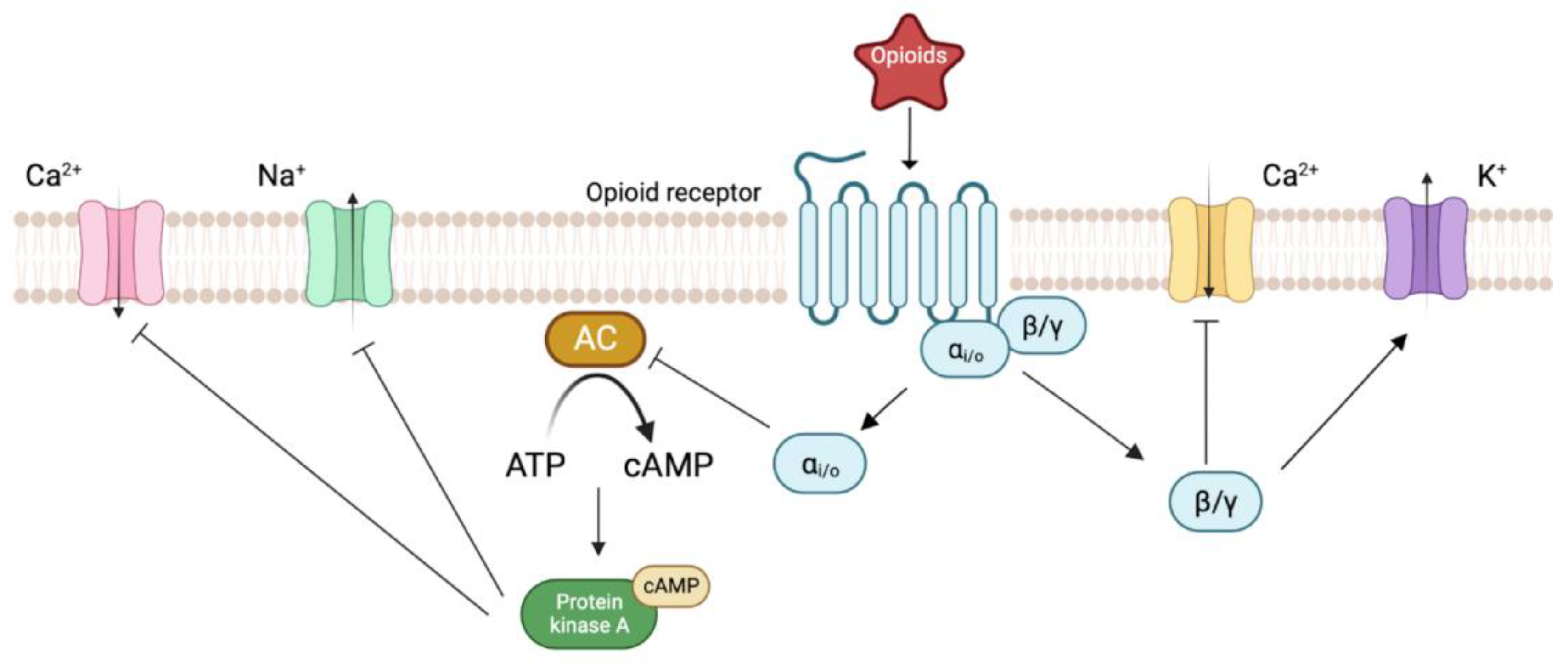
What happens to cAMP levels when adenylyl cyclase is inhibited by Gi/o proteins?
cAMP levels decrease inside the cell.

What is the consequence of lower cAMP levels on protein kinase A (PKA)?
Lower cAMP causes less activation of PKA.
How does reduced PKA activity affect ion channels?
It leads to the opening of potassium (K⁺) channels and closing of calcium (Ca²⁺) channels.
What effect does opening K⁺ channels have on a neuron?
Opening K⁺ channels hyperpolarizes the neuron, making it less likely to fire.
What effect does closing Ca²⁺ channels have on neurotransmitter release
It reduces neurotransmitter release.
What happens to the GABAergic neuron when opioid receptors are activated?
the GABAergic neuron becomes less active (inhibited) and releases less GABA.
How does inhibition of GABAergic neurons by opioids affect dopamine neurons?
: Inhibition of GABAergic neurons causes disinhibition of dopamine neurons, increasing dopamine release.
Summarize the cellular pathway activated by opiates binding to opioid receptors.
piates activate opioid receptors coupled to Gi/o proteins → Gi/o inhibits adenylyl cyclase → decreased cAMP and PKA activity → opening of K⁺ channels and closing of Ca²⁺ channels → suppressed neuronal excitability and neurotransmitter release.
What happens to a neuron when K⁺ channels open?
Potassium ions (K⁺) leave the neuron, causing hyperpolarization, which makes the neuron less likely to fire.
What is the effect of closing Ca²⁺ channels on neurotransmitter release?
Closing Ca²⁺ channels reduces calcium entry, which decreases neurotransmitter release.
How does opening K⁺ channels and closing Ca²⁺ channels on GABAergic neurons affect dopamine neurons?
It inhibits GABAergic neurons, reducing GABA release, which disinhibits dopamine neurons and increases dopamine release.
Where does ethanol act to increase dopamine release?
Ethanol acts directly on dopamine (DA) neurons in the ventral tegmental area (VTA).
What is the VTA’s connection to the nucleus accumbens (NAcc)?
Dopamine neurons in the VTA project to the NAcc — forming part of the mesolimbic reward pathway.
What does ethanol do to the afterhyperpolarization (AHP) in dopamine neurons?
Ethanol decreases AHP, making it easier for dopamine neurons to fire again.
explanation: After a neuron fires, it normally experiences an afterhyperpolarization (AHP) — a brief period when the inside of the cell becomes more negative, making it harder for the neuron to fire again.
Ethanol reduces the AHP in dopamine neurons.
This means dopamine neurons recover more quickly after each action potential → they fire more frequently.
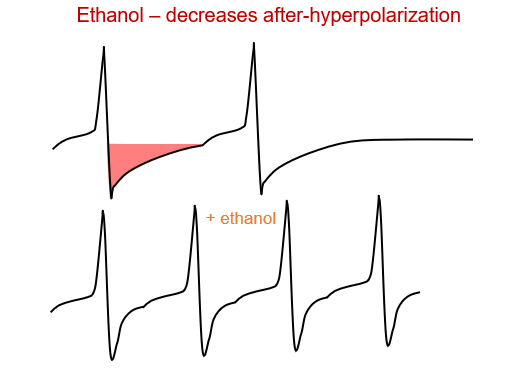
What happens to dopamine neuron firing when AHP decreases?
Dopamine neurons fire more frequently, increasing dopamine release.
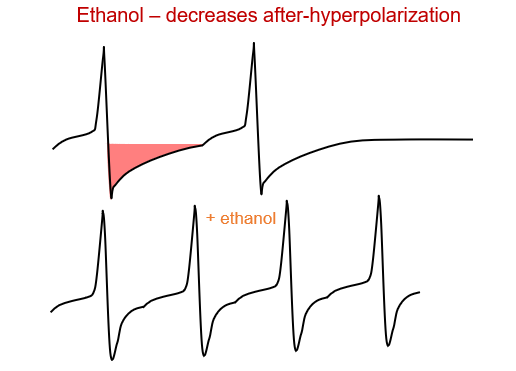
How does ethanol affect GABAergic neurons in the VTA?
Ethanol can inhibit GABA release, reducing the inhibition on dopamine neurons.
What is the overall effect of ethanol on dopamine release in the NAcc?
Ethanol increases dopamine neuron firing and disinhibits them via GABA suppression — leading to more dopamine release in the NAcc.
Why does increased dopamine in the NAcc matter?
More dopamine in the NAcc produces rewarding and reinforcing effects, contributing to alcohol’s addictive properties.
Does ethanol act on only one brain system?
No — ethanol affects many systems in different brain regions and at different doses.
How does ethanol affect after-hyperpolarization (AHP)?
Ethanol decreases AHP, making neurons fire more easily.
How does ethanol interact with GABAA_AA receptors?
Ethanol acts as a GABAA_AA allosteric modulator, enhancing the effects of GABA and increasing neuronal inhibition
How does ethanol affect NMDA receptors?
Ethanol acts as an NMDA receptor antagonist, blocking excitatory glutamate signaling.
What’s the combined effect of ethanol on brain activity?
Ethanol can both enhance inhibition (via GABAA_AA) and reduce excitation (via NMDA and Ca²⁺ channels), depending on dose and brain region — leading to sedation, disinhibition, and reward effects.
Where does nicotine act to influence dopamine release?
Nicotine acts on nicotinic acetylcholine receptors (nAChRs) located on dopamine neurons in the VTA.
hat effect does nicotine have on dopamine neurons in the VTA?
Nicotine increases the firing rate of dopamine neurons.
How does increased dopamine neuron firing in the VTA affect the nucleus accumbens (NAcc)?
It causes more dopamine release in the NAcc, producing rewarding effects.
hat is the overall effect of nicotine on the mesolimbic dopamine pathway?
Nicotine stimulates dopamine neurons in the VTA, leading to increased dopamine levels in the NAcc and reinforcing addictive behavior.
Do nicotinic receptors exist elsewhere in the reward pathway?
yes — they are found in both the VTA and NAcc, where they contribute to dopamine signaling and reinforcement.
Where does THC act in the brain? THC=component in cannabis
THC acts on cannabinoid receptors (CB1 receptors), which are found on GABAergic neurons in the brain.
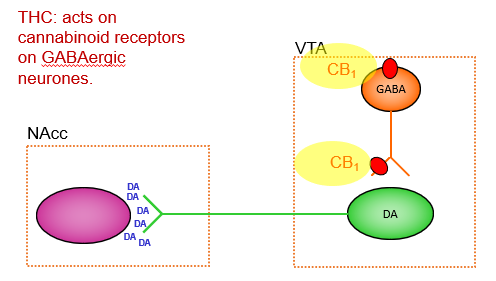
What happens when THC activates cannabinoid receptors on GABAergic neurons?
THC inhibits GABAergic neurons, reducing GABA release.
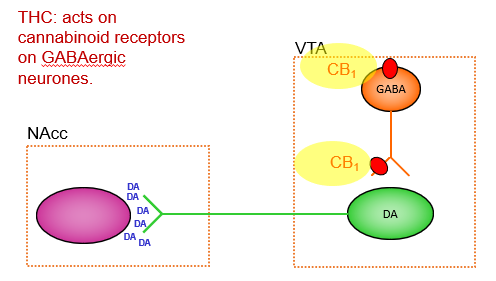
How does inhibiting GABA neurons affect dopamine neurons?
It causes disinhibition of dopamine neurons — they fire more and release more dopamine in the nucleus accumbens (NAcc).
What is the result of THC’s action on the reward pathway?
ncreased dopamine release in the NAcc, leading to rewarding and reinforcing effects similar to other addictive drugs.
What receptor type does THC target?
Cannabinoid receptor type 1 (CB1) — a Gi/o-coupled receptor that inhibits neurotransmitter release.
What receptor does THC activate?
THC activates cannabinoid (CB1) receptors, which are Gi/o-protein coupled receptors.
What happens when CB1 receptors activate Gi/o proteins?
The Gi/o protein inhibits adenylyl cyclase (AC), reducing cAMP levels in the neuron.
What is the effect of decreased cAMP on PKA?
: Less cAMP means less activation of protein kinase A (PKA)
How does reduced PKA activity affect ion channels?
It leads to opening of K⁺ channels and closing of Ca²⁺ channels.
What is the effect of opening K⁺ channels?
Potassium (K⁺) leaves the neuron, causing hyperpolarization, which makes the neuron less excitable.
What is the effect of closing Ca²⁺ channels?
Less calcium enters the neuron, leading to less neurotransmitter release.
What happens when THC acts on GABAergic neurons in the VTA?
THC inhibits GABA release, reducing inhibition on dopamine neurons
How does this affect dopamine neurons and the reward pathway
Dopamine neurons become disinhibited, fire more, and release more dopamine in the nucleus accumbens (NAcc) — producing rewarding effects.
Summarize the whole pathway from THC to dopamine release
THC → CB1 (Gi/o) activation → ↓ adenylyl cyclase → ↓ cAMP → ↓ PKA → open K⁺ & close Ca²⁺ channels → inhibit GABA → disinhibit dopamine → ↑ dopamine in NAcc.